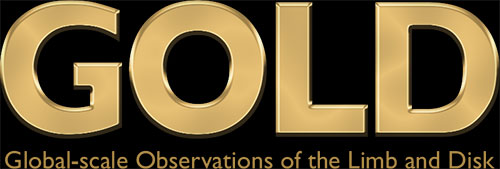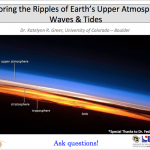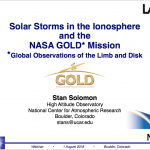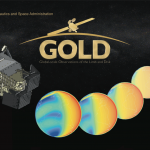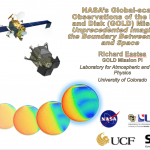GOLD Science Communications Webinars are virtual gatherings of GOLD team members involved in bringing the science and engineering of the mission to the public. The purpose of the webinars is to offer a unique perspective on the mission to those interested in GOLD and NASA heliophysics science generally, so that we can keep the public updated on the latest data from GOLD, as well as the science related to NASA’s exploration of the near-Earth space environment.
By sharing information, resources, and experiences, participants in these virtual gatherings will be connected to the mission in a unique way and take part in this valuable opportunity to engage with the mission and with each other.
GOLD Science Communications Webinars
February 27, 2019—The GOLD Ground System: How Data Gets from the GOLD Instrument to Publicly Available Science Data Products
Presenter: GOLD Science Operations Center Manager, Karen Bryant
Download the presentation:
How do we go from generating and uploading commands, to receiving data from the instrument and converting that data into publicly available science data products? In this webinar, we’ll follow the GOLD instrument data paths and take a detailed look at the GOLD ground system.
We’ll look at how the ground system was developed and tested, and where it stands today.
Download Audio Only (26 MB mp3)
September 26, 2018—Exploring the Ripples of Earth’s Upper Atmosphere: Waves and Tides
Presenter: GOLD research scientist, Katelynn Greer
Download the presentation:
Earth’s upper atmosphere is a region of great activity and change. Some of this activity comes from above, from the Sun, and some of the activity comes from below, driven by the weather near Earth’s surface. But in the upper atmosphere, the activity from below and above mix, creating extraordinary variable in the ‘weather’ experienced by this region.
GOLD will have an unprecedented view of this activity and in this GOLD science webinar, we will discuss the activity that comes from below, primarily in the form of waves and thermal tides.
Download Audio Only (12 MB mp3)
August 1, 2018—Solar Storms in the Ionosphere and the NASA GOLD Mission
Presenter: GOLD science co-investigator, Stan Solomon
Download the presentation:
The GOLD mission has reached geostationary orbit and will soon begin capturing unprecedented images of Earth’s interface to space.
In this GOLD Science Communications Webinar from August 1, 2018, GOLD scientist Stan Solomon discussed how the GOLD instrument—an ultraviolet imaging spectrograph—will measure the response of the Earth’s upper atmosphere to changes in solar activity.
Download Audio Only (20 MB mp3)
March 21, 2018—GOLD: Hitching a Ride on a Commercial Communications Satellite
Presenter: GOLD Project Manager, Rory Barrett
Download the presentation:
The NASA GOLD mission launched successfully on Jan. 25, 2018, and is making its way into geostationary orbit, some 22,000 miles above the Earth.
In this GOLD Science Communications Webinar from March 21, 2018, GOLD Project Manager, Rory Barrett, discussed how the GOLD instrument—an ultraviolet imaging spectrograph—will capture unprecedented images of Earth’s interface to space as a hosted payload onboard SES-14, a commercial communications satellite.
Download Audio Only (18 MB mp3)
February 28, 2018—Unprecedented Imaging of Earth’s Space Environment from Geostationary Orbit
Presenter: GOLD Principal Investigator, Richard Eastes
Download the presentation:
NASA’s Global Scale Observations of the Limb and Disk, or GOLD, mission launched successfully on January 25, 2018, as a hosted payload on SES-14, a commercial communications satellite that will operate in geostationary orbit.
In this GOLD Science Communications Webinar from February 28, 2018, GOLD Principal Investigator, Richard Eastes, discusses how the GOLD instrument—an ultraviolet imaging spectrograph—will capture unprecedented images of the Earth and provide valuable insight into how the near-space environment responds to inputs from the Sun above and the lower atmosphere below.
Download Audio Only (24 MB mp3)
